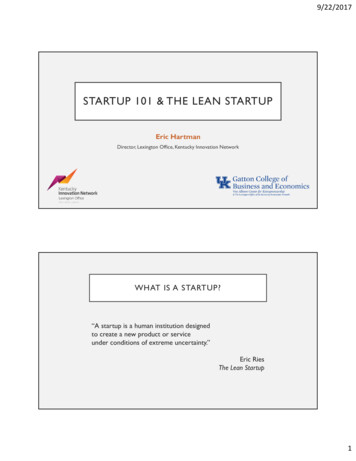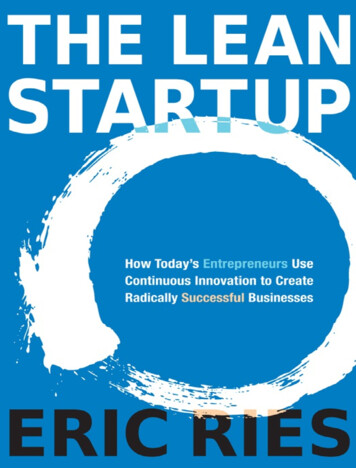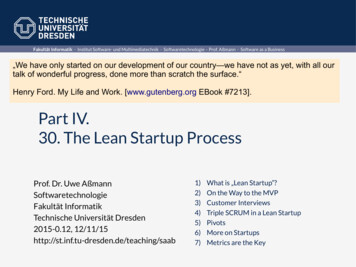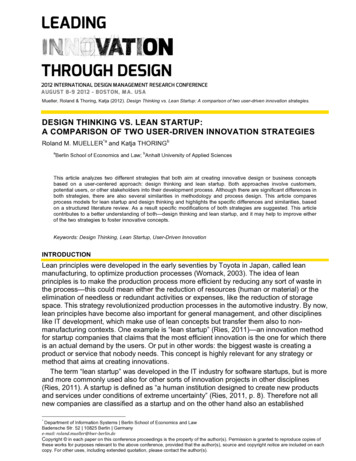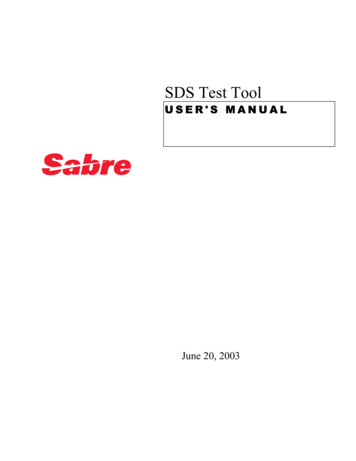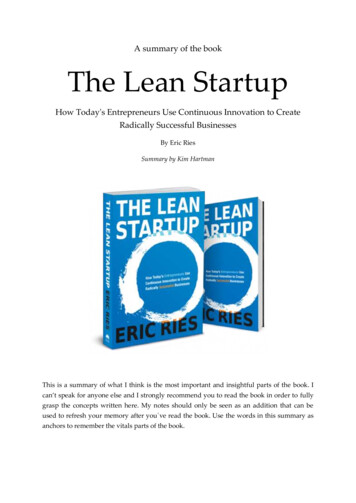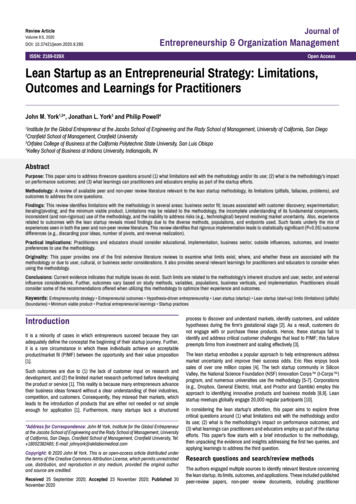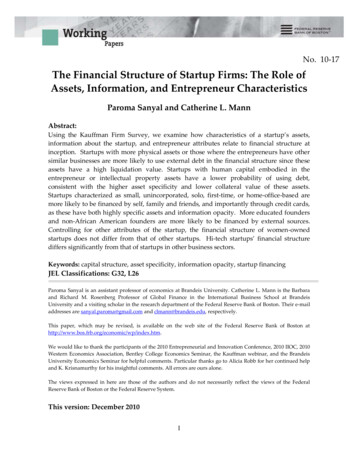
Transcription
No. 10-17The Financial Structure of Startup Firms: The Role ofAssets, Information, and Entrepreneur CharacteristicsParoma Sanyal and Catherine L. MannAbstract:Using the Kauffman Firm Survey, we examine how characteristics of a startup’s assets,information about the startup, and entrepreneur attributes relate to financial structure atinception. Startups with more physical assets or those where the entrepreneurs have othersimilar businesses are more likely to use external debt in the financial structure since theseassets have a high liquidation value. Startups with human capital embodied in theentrepreneur or intellectual property assets have a lower probability of using debt,consistent with the higher asset specificity and lower collateral value of these assets.Startups characterized as small, unincorporated, solo, first-time, or home-office-based aremore likely to be financed by self, family and friends, and importantly through credit cards,as these have both highly specific assets and information opacity. More educated foundersand non-African American founders are more likely to be financed by external sources.Controlling for other attributes of the startup, the financial structure of women-ownedstartups does not differ from that of other startups. Hi-tech startups’ financial structurediffers significantly from that of startups in other business sectors.Keywords: capital structure, asset specificity, information opacity, startup financingJEL Classifications: G32, L26Paroma Sanyal is an assistant professor of economics at Brandeis University. Catherine L. Mann is the Barbaraand Richard M. Rosenberg Professor of Global Finance in the International Business School at BrandeisUniversity and a visiting scholar in the research department of the Federal Reserve Bank of Boston. Their e-mailaddresses are sanyal.paroma@gmail.com and clmann@brandeis.edu, respectively.This paper, which may be revised, is available on the web site of the Federal Reserve Bank of Boston athttp://www.bos.frb.org/economic/wp/index.htm.We would like to thank the participants of the 2010 Entrepreneurial and Innovation Conference, 2010 IIOC, 2010Western Economics Association, Bentley College Economics Seminar, the Kauffman webinar, and the BrandeisUniversity Economics Seminar for helpful comments. Particular thanks go to Alicia Robb for her continued helpand K. Krisnamurthy for his insightful comments. All errors are ours alone.The views expressed in here are those of the authors and do not necessarily reflect the views of the FederalReserve Bank of Boston or the Federal Reserve System.This version: December 20101
1. IntroductionLittle is known about the financial structure of startup firms. Theoretical research andmost empirical investigations have focused on large established firms, which can tap an array offinancial sources, such as stock equity or commercial paper, a situation quite different from thatfacing small firms. Most empirical research on small firms has focused on ongoing firms. Yet,recent research has revealed the importance of startups for economic vibrancy and job creation.(Haltiwanger, Jarmin, and Miranda, 2010; Kane, 2010; Stangler, 2010). During times of financialcrisis, such as 2008–20010, it is difficult to determine whether credit conditions affect startupactivity without having a benchmark assessment of the financial structure of startup firmsduring more normal credit conditions. This paper draws on the theoretical and empiricalliterature of the financial structure of established firms to develop insights on startups, which arethen examined using the Kauffman Firm Survey.Our sample of startups is drawn from the Kauffman Firm Survey (KFS), where 98percent of the businesses have fewer than 25 employees. 1 We investigate the startups that arenew in 2004, the first year of the survey. The survey detail on these firms is impressive,including detailed data on sector of business activity, financial structure, entrepreneur, andlocation characteristics. 2 Before the KFS survey, such truly new and small business entitieswere little studied.Consistent with theoretical underpinnings based on asset specificity, we find thatstartups with more physical assets or those where the owners have other businesses are morelikely than other startups to have external debt in the financial structure, since these assets havea higher liquidation value. On the other hand, all else being equal, startups with higher humancapital embodied in the entrepreneur or more intellectual property assets have a lowerprobability of using debt, consistent with the higher asset specificity and lower collateral valueof these assets.Usually, researchers classify small firms as entities that have fewer than 500 employees (Acs and Audretsch,1989[1])2 Survival and performance data are available in the follow-on surveys.12
In terms of information opacity, startups located in the entrepreneur’s home are themost opaque and their financial structure is dominated by credit card debt. Team-run startupsand those with serial entrepreneurs are more likely than other startups to have internal andexternal equity in their financial structure, consistent with their greater personal resources andavailable information about the principals.In terms of owner attributes, older and more educated entrepreneurs are more likely touse debt financing, while African-American entrepreneurs are more likely to use their ownresources to finance their businesses.Controlling for other attributes of the startup, thefinancial structure of women-owned startups does not differ from that of male-owned startups.Regional factors and local conditions relate to the financial structure of startups. Areaswith better-educated resident populations are more likely to finance startups using internaldebt. Startups in innovative states and states with higher venture capital (VC) activity have agreater probability of external equity in their financial structure. Startups in larger states have ahigher probability of bank loans in their financial structure at inception.We also find that there are significant dissimilarities in the financial structure betweenhi-tech startups and startups in other sectors. Some of the biggest differences can be traced tothe relationship between financial structure and race, citizenship, and business knowledge (forexample, having related businesses in the same sector).The next section briefly reviews the literature and develops hypotheses on the expectedrelationships between the financial structure of the startup firm and characteristics of its assets,information, and entrepreneurs. Section 3 gives an overview of the Kauffman Firm Survey andour variable definitions and construction. Section 4 presents our estimation methodology andresults. Section 5 concludes.2. Literature ReviewFinancial structure is central to a firm’s business strategy and has important implicationsfor firm behavior.In extensions of Modigliani-Miller (1958), theoretical analyses of largeestablished firms have addressed how the degree of asset specificity (asset value at bankruptcy)and information opacity (aligning manager and share-holder interest) influences governance3
and financial structure. Established-firm theory finds that, on the one hand, firms with highlyspecific assets (low liquidation value at bankruptcy) should have a higher proportion of equityrelative to debt, since stockholders in principle can exercise greater control over the operationsof the firm, whereas debt-holders cannot appropriate the highly specific assets. On the otherhand, under conditions of information opacity about managers’ activities, after internalresources, the firm should use bank debt, which disciplines management, and lastly equity,where ensuring the alignment of interests between managers and shareholders is more difficult.Our question: does the ranking with regard to internal funds, external debt, and external equitythat comes from established-firm theory play out for startups, which have different asset andinformation characteristics as well as a different set of financial sources?Previous research points out that, in the case of startups, there are no ongoingoperations and no track record by which to judge the firm. This information opacity makesexternal financing more difficult to obtain at the nascent stages (Bruno and Tyebjee, 1985;Manigart and Struyf, 1997; Cassar, 2004; Avery et al., 1998; Berger and Udell, 1995; Paulson andTownsend, 2004).A startup’s potential external equity investors (such as angel or venturecapital) may have limited information about the founder (unless s/he is a serial entrepreneur) orthe prospects for the enterprise and may therefore demand a high ownership stake for a givenfinancial outlay. From the standpoint of the owner-founder, internal finance is preferred,followed by external debt such as bank financing, and only lastly would the founder useexpensive external equity where s/he has to give up a large ownership stake (Berger and Udell,1995; Scholtens, 1999; Huyghebaert and Gucht, 2007).However, these predictions based on information opacity are qualified by thecharacteristics of the assets of most startups. In small startups the entrepreneur not onlysupplies managerial expertise, but also provides financial, knowledge, and human capital to thefirm (Hart and Moore, 1995; Audretsch et al., 2009). Such specific human capital may not beeasily transferable to alternative uses, which compounds the information opacity problem(Klein at. al. 1978; Williamson, 1975, 1985; Balakrishna and Fox, 1993; Kochhar, 1996; VincenteLorente, 2001). The ‘inalienable’ nature of human capital of the entrepreneur (Hart and Moore,1994) exacerbates the tension between debt holders and the owner because the owner can4
threaten to walk away. Therefore, firms with a high degree of asset specificity should befinanced primarily by the entrepreneur’s own resources, followed by external equity such asventure capital, and last by external debt.Insights gleaned from theory suggest that startups would use internal funds first,followed by external resources, with the predictions on the external debt-equity mix unclearand dependent on the relative importance of asset specificity and information opacity.However, despite this theoretical preference for internal finance, Berger and Udell (2003)reveals the importance of debt financing for young firms in the United States, including highgrowth startups. 3 Therefore, in practice, resource constraints faced by the entrepreneur meanthat startups are likely to rely primarily on external financing of one sort or another. Ouranalysis using the detailed financial data in the KFS helps tease out the relative importance ofinternal equity and debt versus external equity and debt in the financial structure of startups, aswell as the type of external debt.Outside the issues of asset specificity, information opacity, and financial constraints,substantial empirical work focuses on the relationship between financial structure andentrepreneur characteristics such as their education (Bates, 1990; Cressy, 1996; Chandler andHanks, 1998; Baum and Silverman, 2004; Astebro et al., 2005), race and ethnic ties (Bates, 1997a,b; Smallbone et al., 2003), gender (Fay and Williams, 1991; Verheul and Hurik, 2001), strategicalliances and networks (Petersen and Rajan, 1994; Coleman, 2000; Baum and Silverman, 2004;Chang, 2004), and experience of the founding team (Delmar and Shane, 2006). Using the KFSallows us to examine these entrepreneur characteristics in conjunction with financial structure.With regard to race and gender, the KFS allows us to examine whether the financial structure ofAfrican-American and women-owned firms differs from that of other startups, and specificallyto examine whether they have less external funding.They show that for startups less than two years old, debt accounts for 52 percent of capital structure, which is in linewith the 50 percent debt found for all firms. Additionally, even high-growth firms have as much as 33 percent debtby the time they go public.35
The contribution of this paper arises from the fact that the KFS allows us to look at thefinancial structure of firms at inception and compare that to both the theories of establishedfirms and the empirical investigations of ongoing small firms.We expect:H 1: When information about the activities of the startup are particularly opaque,internal finance is used, followed by external bank debt, and last, by external equityH2: When assets of the startup are highly specific, internal finance is used, followed byexternal equity such as venture capital, and last, by external bank debt.H3: African-American and/or women-owned startups do not use external sources offunds.3. Kauffman Firm Survey and Variable ConstructionThe primary data are obtained from the Kauffman Firm Survey (KFS), which tracks fromyear-to-year a panel of about 5,000 businesses.Each business has a unique identificationnumber, and the original survey posed more than 1,400 questions to each firm in the survey,including detailed questions on financial structure, owner and founder characteristics, businessand innovation activity, and location. 4 Because we are interested in the financial structure ofthe startup at inception, we examine the firms in their founding year in 2004. 5The KFS new venture is defined as “a new independent business that was created by asingle person or a team of people; the purchase of an existing business; or the purchase of aThe KFS firms were drawn from all new businesses that were started in 2004 (and did not die within one year) asrepresented by the 237,843 enterprises in the Dunn and Bradstreet. The data were partitioned into six strata based onthe industry technological category and the gender of the owner or CEO of the business. The industry technologyclassification ensured that a large sample of high-technology new businesses was represented in the KFS. The gendercategory ensured that women-owned businesses were sufficiently represented in the final sample, although suchbusinesses were not oversampled. The weighted response rate (after including the sample weights) was 42.9 percent.See Kauffman Firm Survey 2005/2006: Baseline/First Follow-up (Scott Shane, Alicia Robb, Mathematica PolicyResearch Institute) for a detailed construction of the sampling weights and industry technological categories.5 The latest survey (third follow-up) was released in March 2009 and contains many additional variables such as thecredit risk of the business and the source of competitive advantage as identified by the entrepreneur, as well asinformation about performance and survival.46
franchise.” 6 We consider only true startups, not purchased or franchise firms, yielding oursample of 4,201 startups from the total KFS new venture total of 4,630.The KFS has detailed data (about a dozen different categories) on the types and amountof financing.The grossest disaggregation distinguishes between debt and equity in thefinancial structure. Along these lines, summary statistics for the 2004 sample (reported in Table1A) show that for the average startup, 64 percent 7 of financing at inception is internal equity(primarily the entrepreneur’s own resources), 30 percent is external loans, and the rest is madeup of loans from friends and family and external equity financing. Compared with previouswork on small firms (Berger and Udell, 2003) this suggests a much greater role for internalresources at startup than for young firms with ongoing operations. However, there is significantvariation around these averages and this gross distinction between debt and equity does nottake advantage of the KFS detail.3.1 Financial Structure VariablesThe rich detail in the KFS allows a deeper investigation of financial structure. Sincemost firms are financed primarily by only one type of finance, we use discrete variables (forexample, the binary 0,1) when describing financial structure for each firm. 8 (See Table 1B). Internal equity: 1 when the equity is entirely (or primarily) owned by entrepreneur/owners,their spouses and family, and/or by the employees of the company. About 26 percent ofstartups use internal equity as the primary method financing.Kauffman Firm Survey 2005/2006: Baseline/First Follow-up (Scott Shane, Alicia Robb, Mathematica Policy ResearchInstitute). See also: http://www.kauffman.org/uploadedFiles/kfs fourth 040709.pdf7 Figure is derived from 68 percent internal financing times 93.5 percent internal equity.8 Empirical work on established firms often uses the share of different types of financing instead of the 0-1 binarychoice. However, for the startup financial data, the 0-1 choice variable is superior because some of the shares aresmall while others are at such extremes that there would not be a normal distribution for the share variable.Nevertheless, in 80 percent of the sample, there is a mix of finance used at startup inception. To investigate therobustness of our results to alternative cut-offs for the binary choice, we considered cutoffs ranging from 75 to 95percent. That is, the internal equity dummy takes the value 1 if the share of internal equity financing was greaterthan 75, 80, 85, 90 or 95 percent. Robustness checks show that our results are unaffected by the choice of cutoff. Forthe financial structure index used in the reported regressions we use the 75 percent cutoff.67
Internal debt: 1 when the entrepreneur takes loans from family, and/or employees, orborrows from other personal sources. About 3 percent of firms use this type of financing. External debt: 1 when the business takes loans from banks, the government, business loansfrom business credit cards, other businesses, and/or from other sources. Seventy percent ofstartups use external debt to start their business. Of this external debt used to fund startups,58 percent of the value of external debt is credit card debt, 5.6 percent is bank debt, and therest is loans from government and other sources. External equity: 1 when equity financing is obtained from angels, other businesses,government, venture capital, and/or other sources. Approximately 1.4 percent of venturesuse external equity financing in their initial year of operation.Because external debt is so important, and because the decomposition of external debt intocredit card and bank loans is important from a policy perspective, we also examine financialstructure decomposed six ways: Owner resources: 1 when the equity is entirely (or primarily) owned by entrepreneur/owners Other internal resources: 1 when equity is owned by spouses and family, or by the employeesof the company, and when an entrepreneur takes loans from family, and/or employees, orborrows from other personal sources. External debt—credit cards: 1 when the business is primarily funded by credit cards External debt—bank loans: 1 when the business is primarily funded by bank loans External debt—other: 1 when the business in primarily funded by other business andgovernment sources. External equity: 1 when equity financing is obtained from angels, other businesses,government, venture capital, and/or other sources3.2 H1 and Measures of Information OpacityH1 implies that the greater is information opacity in a startup, the greater is the share ofinternal finance, with external debt such as bank financing next, and external equity the least8
used. To test this hypothesis we create three measures of information opacity: whether the firmoperates from a home office, whether it is run by a team, and whether it is started by a serialentrepreneur. (See Table 1C.) Home office dummy: 1 when the venture is based in the home of the founder. Fifty-ninepercent of startups are located at the residence of the entrepreneur. Team-run business: 1 when there are two or more active owners. Twenty-nine percent ofstartups are run by teams. Serial entrepreneurship: the total number of new ventures started by the owners of thisventure. This measure varies between 0 and 140 9 for the entire sample; on average, ownershave started 1.4 new businesses.Startups that lease an office provide enough information to rent commercial real estate. Serialentrepreneurs have a track record. Firms with multiple owners may have greater personalresources and, therefore, less need for other financial resources; but with more owners, at leastone might be known to the financial community, mitigating the information opacity problem.Therefore, based on H1, startups operating from a home office, that are run by solo and/or firsttime entrepreneurs are likely to have the greatest information problems. For these startups,internal resources are likely to dominate financial structure, followed by external debt and verylittle external equity.3.3 Measures of Asset SpecificityH2 implies that the greater is asset specificity in startups, the higher is the shareof internal finance, followed by external equity such as equity from angels/venturecapitalists, and finally by external debt. To test this hypothesis, we create five measuresof asset specificity spanning both specific human capital, and intangible and tangibleassets.Each business may have anywhere between 1 and 14 owners. This is the total number of businesses started by allthe owners in aggregate.99
Business knowledge: the number of businesses owned by all the entrepreneurs (whoare also managers of the business) 10 in the same industry as this current venture. Amajority of the entrepreneurs do not own other businesses in the same industry,although there is a wide dispersion, with some entrepreneurs owning up to sixbusinesses in the same industry. This variable measures knowledge of the businesssector (human capital), but it may also proxy for the availability of other businessassets that could be used as collateral (tangible capital). Industry experience: total years of work experience of the entrepreneurs (who are alsomanagers of the business) in the same industry as this current venture. 11 The totalwork experience of all the entrepreneurs is between zero and 150 years, the largernumber being for startups with a large number of owners. On average,entrepreneurs in firms have 14 to 17 years of work experience in the same industry. Tangible assets: cash on hand, and the value of buildings, machinery, and otherproperty owned by the firm. Tangible assets can serve as collateral for obtainingloans from external sources and can have relatively high liquidation value comparedwith intangibles. Intellectual property: Total units of intellectual property (IP) owned by the venture:patents, copyrights, and trademarks. The distribution of IP varies between 0 and103, with an average firm holding about 1.5 units. R&D personnel: the share of employees engaged in research and development(R&D). In 2004, the average startup had 38 percent of employees engaged in R&D.We include the business experience of the owners as a specific asset only if the entrepreneurs are also the managersor operators of the business. Otherwise, if they hire a manager, the human capital of the entrepreneur may not beimportant for the success of the business.11 As alternative measures of specific human capital, we have used the number of businesses and work experience ofthe primary owner, the mean number of businesses and work experience of all the owners; the results in oureconometric estimates are unaltered.1010
Tangible assets have high liquidation value in bankruptcy. Other businesses owned bythe entrepreneur may be pledged as collateral or their retained earnings used to financethe new firm. The value of intellectual property and the activities of R&D personnel, onthe other hand, are less certain. If the firm owns patents that can be licensed out or soldto other firms, then such an asset would have low specificity and potentially highliquidation value. But, for most of our sample, IP consists of trademarks and copyrightsthat are particular to a venture and that may be valuable as ongoing assets, but wouldhave low liquidation value.Following H2, we expect startups with high amounts of human capital to befinanced primarily by internal sources, and specifically by internal equity. We expectfirms with a high proportion of tangible assets or access to other businesses to have apreponderance of external financing, and within that to use debt financing rather thanequity financing. We expect firms with a high proportion of intangible assets to havemore internal financing, followed by external equity, and then external debt.3.4 Entrepreneur AttributesH3, which is derived from other empirical work, implies that African-American and/orwomen-owned startups do not use external sources of funds. To test this hypothesis we use therich array of entrepreneur characteristics in the KFS. 12oBlack primary owner: 1 when the main owner is of African-American descent. Eight-and-ahalf percent of startups in the KFS sample have African-American owners.oWoman primary owner: 1 if the main owner is a woman. Twenty-six percent of startups inthe KFS sample have a woman as the primary owner.One characteristic of owners and startups that is not available in the KFS dataset is owner wealth. Wealth of theowners is an important underpinning of financial structure and it is unfortunate that we lack this information. Weattempt to get at this aspect through the variables measuring startup characteristics in the next sub-section.1211
oAge of the primary owner: Measures general life experience and potentially more extensivebusiness networks. The average age of the entrepreneur in our sample is about 45 years,although the range of ages varies between 17 and 87 years.oFounder education: 1 when the primary owner has some college-level education. 13 In the KFSsample, about 60 percent of entrepreneurs have some higher education.oU.S. citizen primary owner: 1 when the entrepreneur is a U.S. citizen. Approximately 96percent of entrepreneurs in the KFS sample are U.S. citizens.From the previous literature we expect businesses owned by women and African-Americans tohave greater difficulty in obtaining all forms of external financing, and therefore we expect toobserve a preponderance of internal source financing, such as funding from the founder,friends, and family. With regard to citizenship, the tightening of credit regulations (‘know yourcustomer’) after September 11, 2001 may mean that U.S. citizens will be relatively more able toaccess bank loans than non-citizens. On the other hand, non-U.S. citizens may have tighternetworks, which can help with financing (Saxenian).Following H3, we expect non-Black, non-woman startups; and startups with olderfounders, more education, and U.S. citizenship, to have better credit market access, andtherefore a higher likelihood of having external finance dominate in the financial structure ofthe startup.3.5 Venture, Industry, and Spatial ControlsIn our sample of startups, there is significant variation in the concentration of startupsby state and industry. By location, 11 percent of the ventures are located in California, followedby 7.6 percent in Texas, 5 percent in Michigan and Florida, and 4.5 percent in New York. Byindustry, 25.7 percent of businesses are concentrated in Professional, Scientific or TechnicalServices, 11 percent in Primary Metal Manufacturing, about 8 to 9 percent each in Construction,We also constructed alternative measures, such as a dummy for any of the owners having some college experience,or any of them having graduate degrees. In our econometric specification the results were very similar to thosepresented.1312
Administrative and Support and Waste Management and Remediation Services and OtherServices, and another 5.6 percent in Retail Trade.We use various venture, industry, and state demographic and economic data as controls.We match these data with the KFS data by using the year, NAICS code, and state variable. Toavoid endogeneity, we lag the state-level variables. Size: Number of employees in the startup year. This measure ranges from 0 to 1,100. Onaverage, most firms have two employees, with the median firm having only one employee. Incorporated company: 1 when the startup is a limited liability company, a subchapter Scorporation, a C-corporation, a general partnership, or a limited partnership company. Inour sample about 65 percent are incorporated firms.oHi-Tech Industry: 1 when the firm is classified as one of the 6-digit, hi-tech NAICS sectors.Five hundred and eighty-seven (or about 14 percent of the sample) are hi-tech startupsusing this definition. 14oHighly educated population: log value of the number of graduate students in the state fromNational Science Foundation’s Science and Technology Indicators.oInnovative capacity: R&D intensity in a state. 15oState size: total population from Bureau of Labor Statistics.oVC activity: the number of venture capital (VC) deals from PricewaterhouseCoopers MoneyTree report that is based on data derived from Thompson Financials. The amount of VCactivity varies between 0 and 1,535 deals, with an average of 99 deals per state in 2004. Thisvariable is highly skewed, with states such as California, Massachusetts, and New Yorkreceiving a bulk of the deals. 16Bureau of Labor Statistics NAICS categories are classified as Technology Generators vs. Technology Employers.We use the first definition. Using the second definition gives us comparable results, although the coefficients are lessprecisely estimated since there are fewer ventures that are categorized as hi-tech using the second definition. Inaddition, we considered a hi-tech industry dummy based on the strata that Kauffman uses; there is no substantialchange to our results.15 Defined as R&D spending (from the National Science Foundation’s Science and Technology Indicators) divided bygross state product (from the Bureau of Labor Statistics). As an alternative measure of innovation
Regional factors and local conditions relate to the financial structure of startups. Areas with better-educated resident populations are more likely to finance startups using internal debt. Startups in innovative states and states with higher venture capital (VC) activity have a greater probability of external equity in their financial structure.


